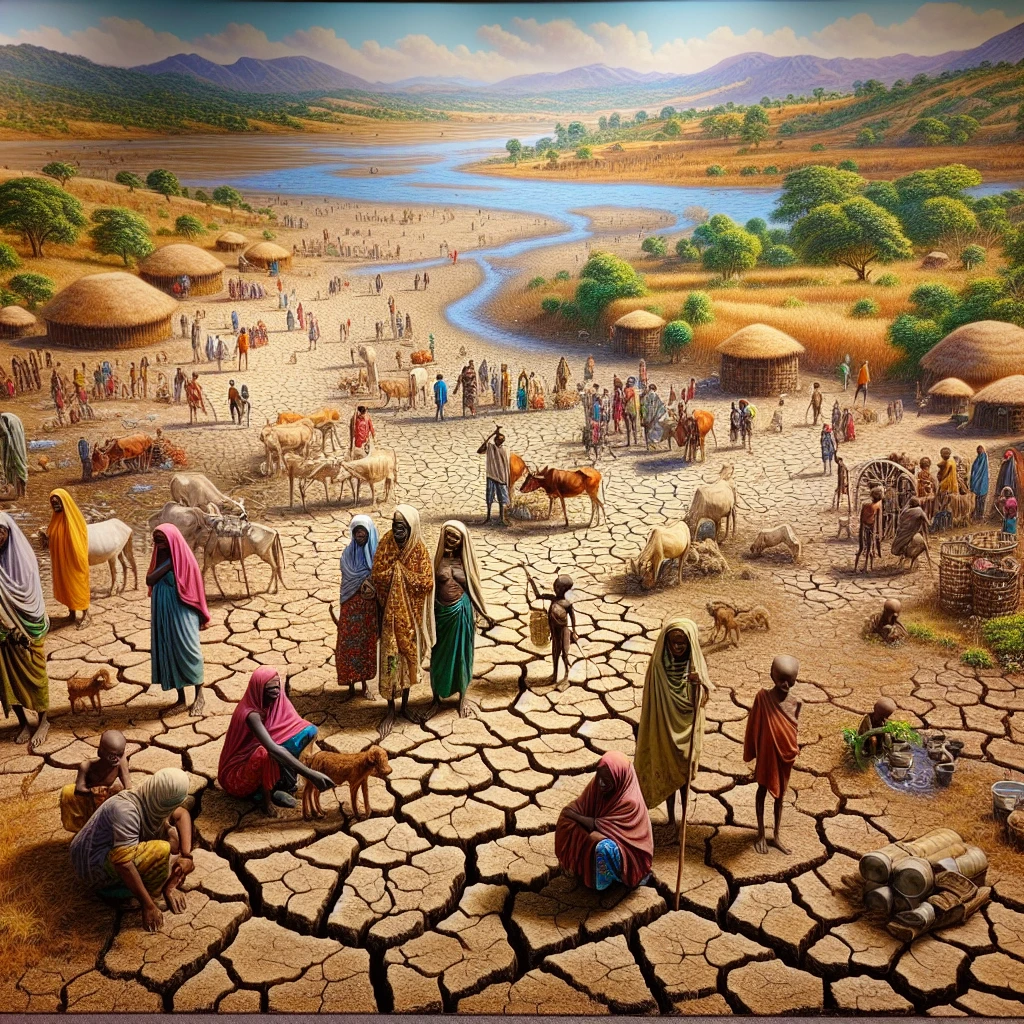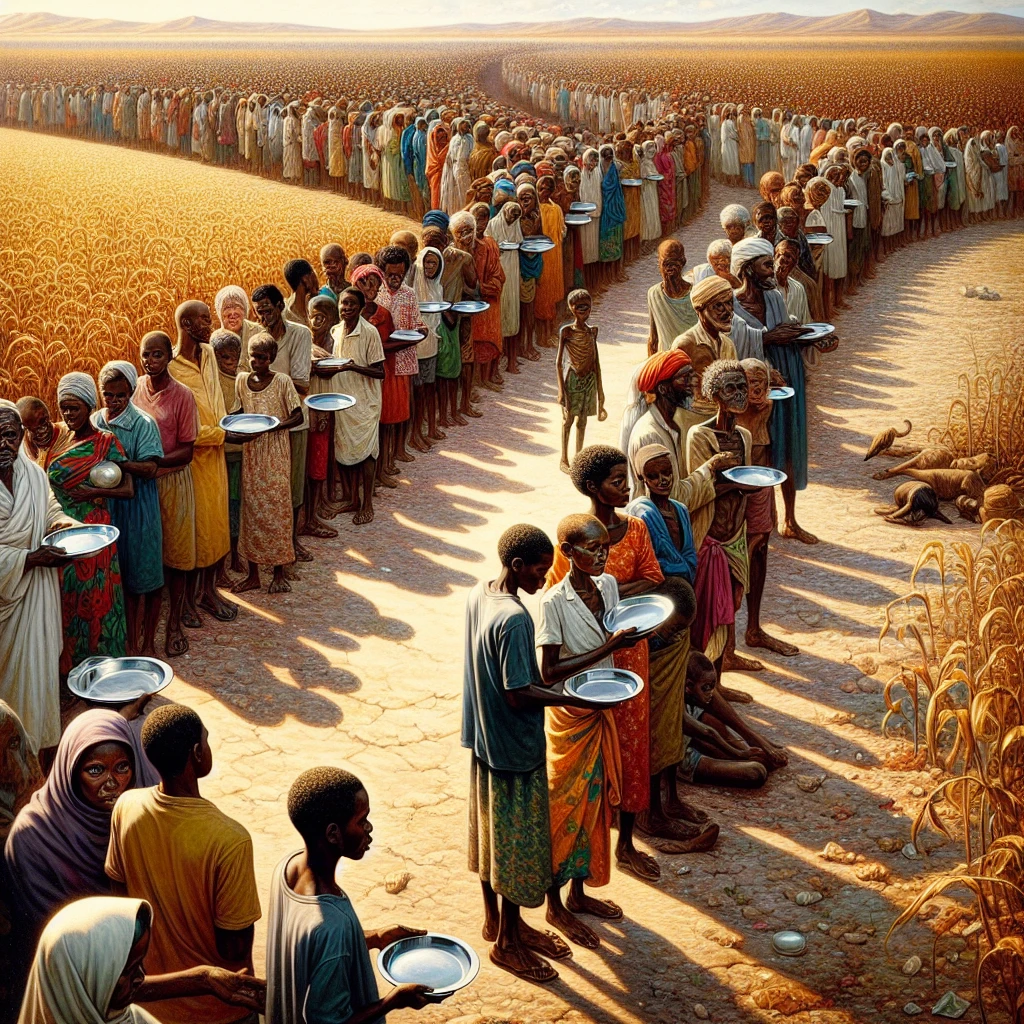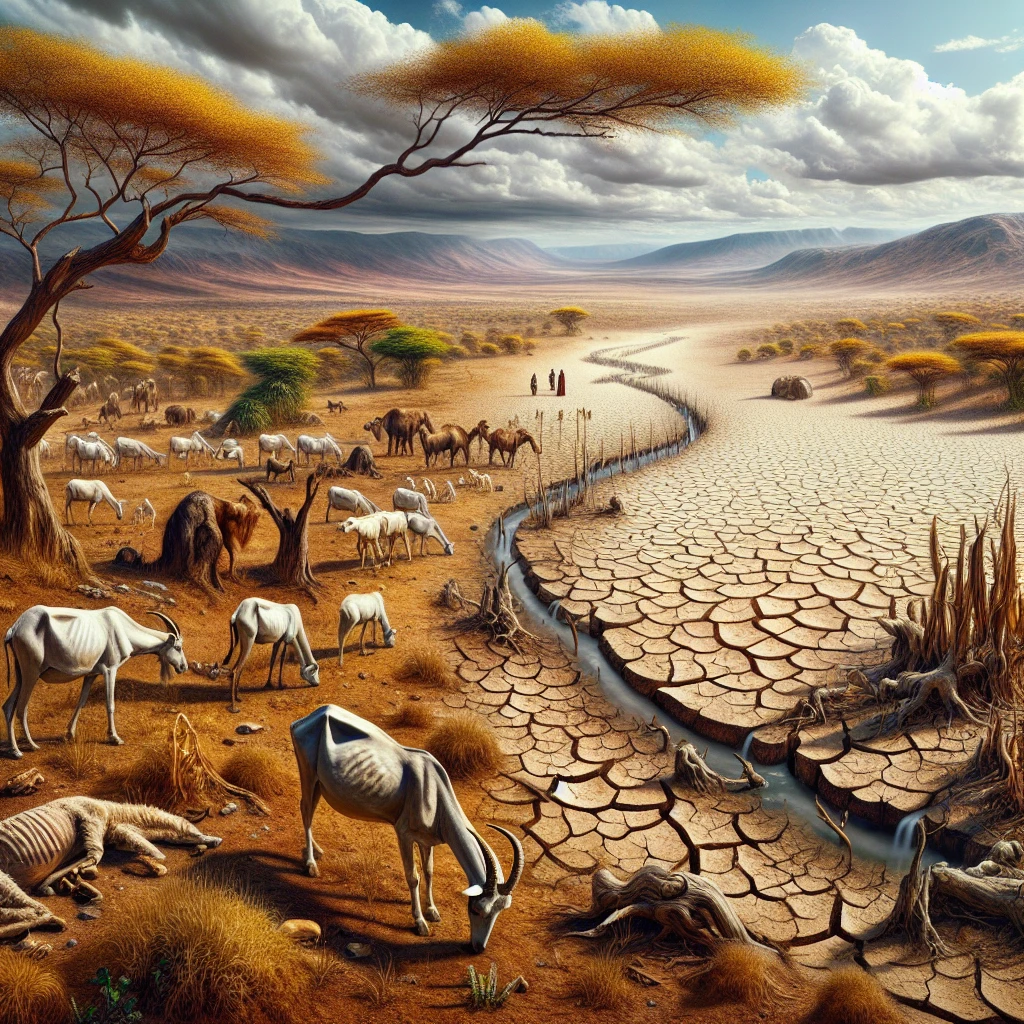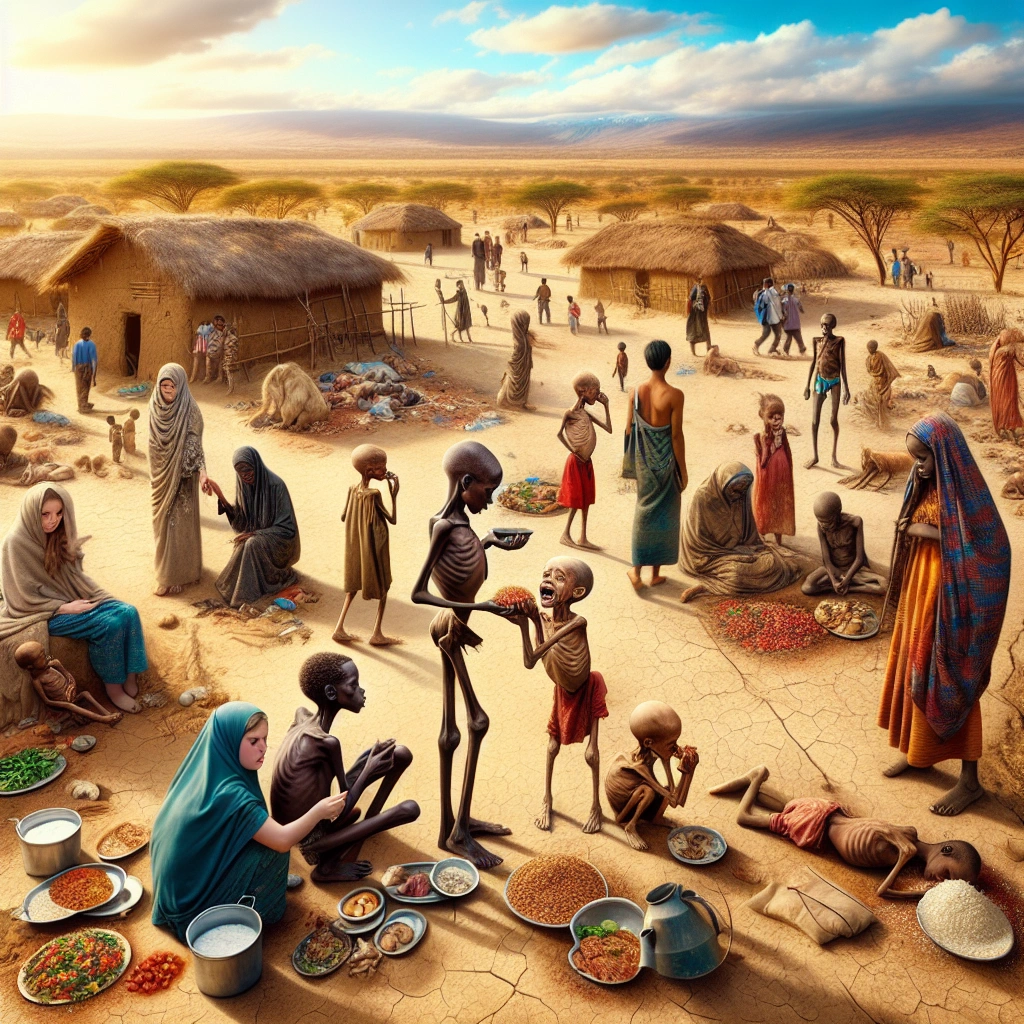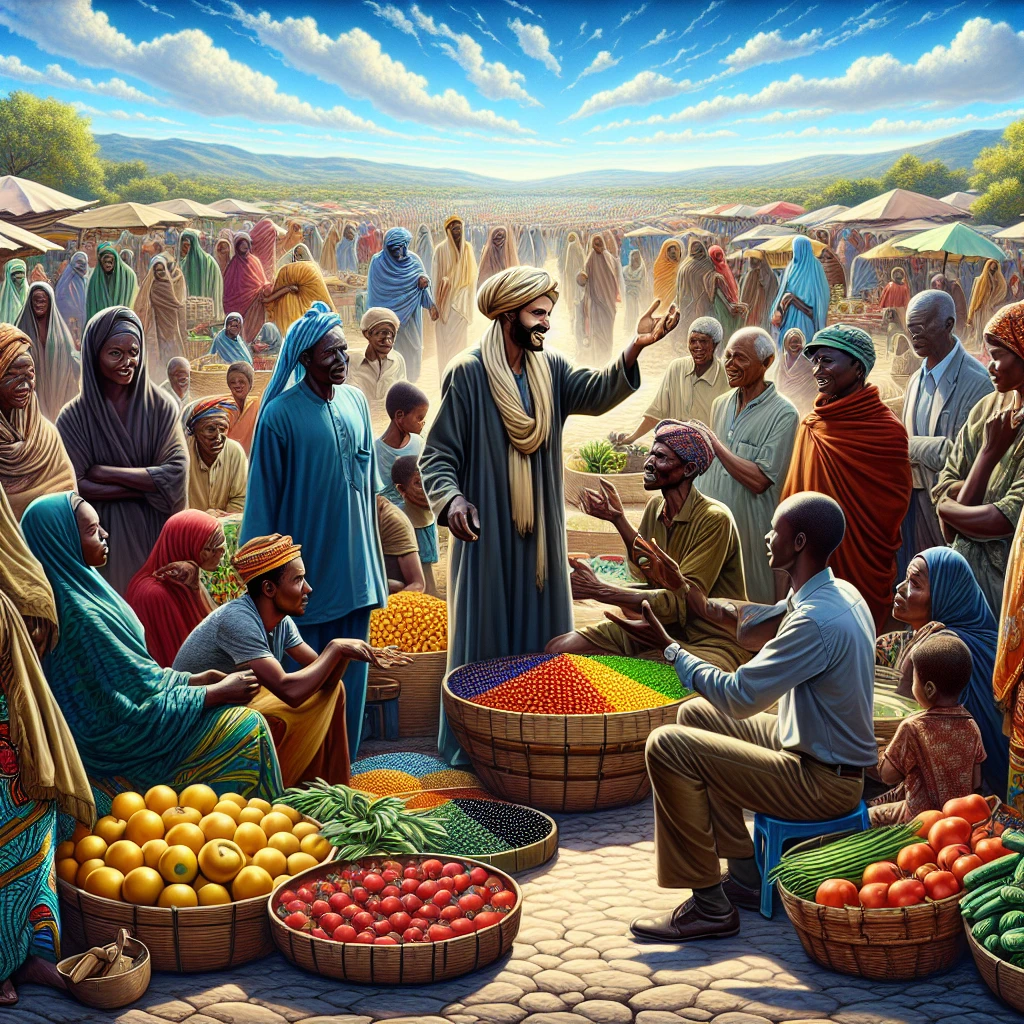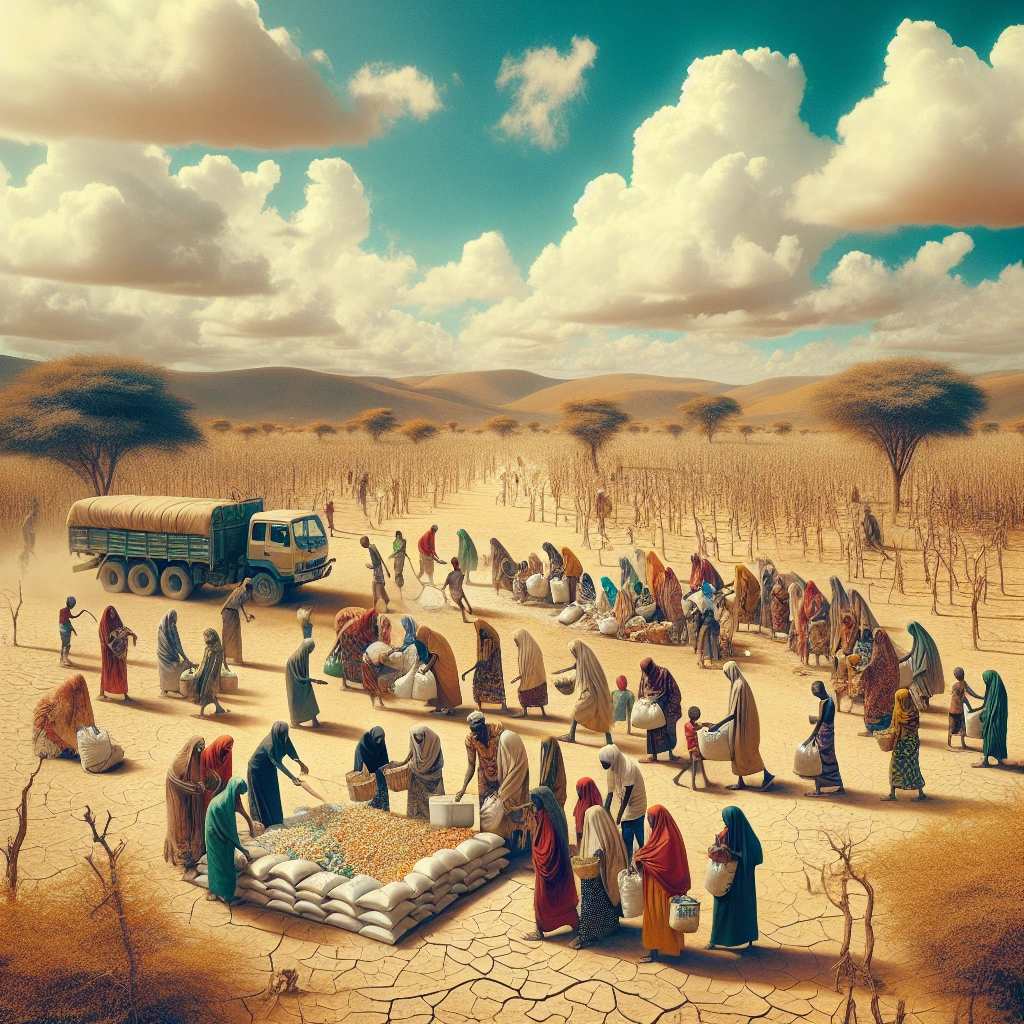

The Horn of Africa is currently facing a severe food shortage crisis, with nearly 60 million people in IPC3+ experiencing acute food insecurity. This represents a 30% increase compared to the first quarter of 2023. In addition, over 83 thousand people are in IPC phase 5 in South Sudan and Somalia, indicating the dire situation in the region.
The importance of understanding the current food shortage statistics in the Horn of Africa cannot be overstated. With millions of people facing acute hunger due to drought, conflict, displacement, and high food prices, it is crucial to have a clear picture of the scale of the crisis.
This understanding is necessary for effective response and intervention efforts to address the pressing food insecurity in the region.
The severity of the situation necessitates urgent action to assist those most at risk due to food insecurity. With over 37 million people in the region projected to reach the third level of the Integrated Food Security Phase Classification scale (IPC3) and higher in the coming months, the need for humanitarian aid and support is evident.
Historical Background of Food Shortage in the Horn of Africa
The Horn of Africa has a long history of grappling with food shortage crises, dating back several decades. Past droughts and conflicts have led to severe food shortages in the region, impacting millions of lives.
These crises have often resulted in widespread famine and humanitarian emergencies, putting immense pressure on the affected countries and international aid organizations.
Factors contributing to the recurrent food shortages in the Horn of Africa are multifaceted. The region’s vulnerability to extreme weather events, such as recurrent droughts and floods, has been a significant driver of food insecurity.
Additionally, conflict and instability in certain areas have exacerbated the situation, leading to population displacement and disruptions in agricultural activities. The combination of these factors has created a persistent cycle of food shortages, posing continuous challenges for the populations in the region.
| Factors Contributing to Recurrent Food Shortages |
|---|
| 1. Extreme Weather Events (Droughts, Floods) |
| 2. Conflict and Instability |
The historical backdrop of food shortage in the Horn of Africa underscores the urgent need for sustainable solutions and proactive measures to mitigate the impact of future crises.
Understanding the Current Situation
Current statistics on food shortage in the Horn of Africa
The current food shortage statistics in the Horn of Africa are dire, with nearly 60 million people in IPC3+ facing acute food insecurity. There has been a 30% increase in this figure compared to the first quarter of 2023. Additionally, over 9.3 million people are in IPC phase 4 and over 83 thousand in IPC phase 5, particularly in South Sudan and Somalia, which indicates an alarming crisis situation.
Comparison with previous years’ statistics
When comparing the current statistics with those of previous years, the gravity of the situation becomes apparent. The 2011 and 2016 to 2017 droughts left 11 million and 15 million people severely food insecure, respectively.
These figures demonstrate a disheartening trend of increasing food scarcity and insecurity in the region over the years.
Impact of climate change on food production in the region
The impact of climate change on food production in the Horn of Africa cannot be understated. Relentless drought and high food prices have greatly weakened people’s ability to grow crops, raise livestock, and access food.
Furthermore, the region received less than 70% of its average precipitation in 2021, leading to a significant decline in crop production, a serious shortage of food availability, and rising prices for essential food items.
| Comparison | 2011 Drought | 2016-2017 Drought | Current Crisis |
|---|---|---|---|
| Severely Food Insecure | 11 million | 15 million | 60 million |
| Severely Food Insecure (South Sudan & Somalia) | N/A | N/A | Over 9.3 million (IPC phase 4) & over 83 thousand (IPC phase 5) |
These statistics emphasize the urgent need for intervention and support to address the food shortage crisis in the Horn of Africa.
Causes of Food Shortage
Drought and its impact on agriculture
Drought in the Horn of Africa has severely impacted agriculture, leading to reduced crop yields and livestock losses. The prolonged dry spells have caused widespread food insecurity, forcing farmers to sell off their livestock and displacing communities.
As a result, countries like Somalia, Kenya, and Ethiopia have experienced significant agricultural disruption and decreased food production due to the adverse effects of drought.
Conflict and its effect on food distribution
Conflict in the region has led to deliberate destruction of farms, livestock, and civilian infrastructure, severely disrupting food distribution and access. Warring parties have plundered food supplies, creating shortages and threatening the survival of entire populations.
This has resulted in decreased availability of production inputs and income, forcing households to rely on less preferred foods. The impact of this food shock is felt across the region, exacerbating food scarcity and insecurity.
Economic challenges contributing to food scarcity
Economic challenges, weak institutions, and fragility have contributed to food scarcity in the Horn of Africa. In the context of conflict and economic instability, limited access to healthy foods, low wages, and adverse social conditions have intensified food insecurity.
COVID-19 has further exposed the fragility of the global food system, highlighting the need for more resilient and equitable systems to address the pervasive issue of food scarcity in the region.
| Country | Food Insecurity Rate | Conflict Impact |
|---|---|---|
| Somalia | 53% | High |
| Kenya | 36% | Moderate |
| Ethiopia | 41% | Significant |
Effects of Food Shortage
Health consequences for the population
The health consequences of food shortage in the Horn of Africa are dire. Acute malnutrition leads to increased migration as populations move in search of food and pasture.
This situation exacerbates the risk of infectious diseases, including cholera, measles, and malaria, due to deteriorating hygiene and sanitation. Moreover, severe malnutrition poses a life-threatening condition for the affected population, leading to a health crisis in the region.
Economic impact on the region
The economic impact of food scarcity in the Horn of Africa is substantial. With relentless drought and high food prices, the ability of individuals to grow crops, raise livestock, and purchase food for their families has significantly weakened.
Furthermore, the conflict in Sudan has contributed to high food and energy prices, further exacerbating the economic challenges faced by the region.
Political implications of food scarcity in the Horn of Africa
The political implications of food scarcity in the Horn of Africa are far-reaching. Left unaddressed, the consequences of this crisis may lead to an uptick in political instability and extremist violence in the region.
Additionally, the mass migration resulting from the crisis poses potential challenges not only within Africa but also on a global scale, likely impacting European shores.
| Food Scarcity Effects | Description |
|---|---|
| Health Consequences | Severe malnutrition leading to increased migration and heightened risk of infectious diseases |
| Economic Impact | Relentless drought, high food prices, and conflict-related repercussions contributing to economic challenges |
| Political Implications | Potential for political instability, extremist violence, and mass migration with global implications |
The effects of food shortage in the Horn of Africa have created a multifaceted crisis, impacting the health, economy, and political landscape of the region. Immediate action and support are crucial to addressing the root causes and mitigating the far-reaching consequences.
Remember, fix the table as per the requirements.
Efforts to Address Food Shortage
International aid and organizations involved
The World Food Programme (WFP), a leading United Nations agency, is actively engaged in providing humanitarian assistance to combat food scarcity in the Horn of Africa. With a focus on supporting vulnerable populations, the WFP is working tirelessly to alleviate hunger and food insecurity through its extensive global network and resources.
Government initiatives to combat food scarcity
The U. S. Department of Agriculture (USDA) has launched significant initiatives to address food scarcity, allocating a substantial budget to strengthen food systems through support for improved production, distribution, and market opportunities. Additionally, the World Bank, in response to the food crisis, is taking proactive measures by supporting vulnerable households and investing in sustainable food security to mitigate the escalating global hunger crisis.
Innovative solutions to improve food production and distribution
In the sustainable food systems industry, startups are leveraging advanced technologies such as sensors, drones, and machine learning algorithms to optimize crop production and enhance overall farm efficiency. Moreover, the USDA plans to invest $5 billion from the American Rescue Plan to improve processing, distribution, and market opportunities, emphasis going into the sustainable, efficient food production and distribution for long-term solutions.
| Organization/Initiative | Description |
|---|---|
| World Food Programme (WFP) | Providing humanitarian assistance globally |
| U. S. Department of Agriculture (USDA) | Investing in strengthened food systems |
| Innovative Startups | Utilizing advanced technologies for optimized crop production |
| American Rescue Plan | Investing in improved processing, distribution, and market opportunities |
These coordinated efforts from international organizations, government bodies, and innovative startups reflect a collective commitment to combat food scarcity in the Horn of Africa and create sustainable, long-term solutions.
Challenges in Providing Aid
Obstacles to delivering aid to affected areas
Obstacles to delivering aid to affected areas can include violence and insecurity, logistical challenges, and remote and hard-to-access populations. For instance, humanitarian access can be obstructed by affected populations or restricted by the government of affected or donor countries.
These challenges hinder the timely and effective delivery of aid to those in need.
Political and logistical challenges in providing assistance
Political and logistical challenges play a significant role in the provision of aid. Issues such as the restriction of entry of humanitarian goods or staff into countries, administrative practices, and laws of governments can hinder aid efforts.
Moreover, the experience of responding to recent challenges, such as the COVID-19 pandemic, has highlighted the need to adapt humanitarian assistance and disaster relief operation logistics.
Impact of COVID-19 on aid efforts in the region
The impact of COVID-19 on aid efforts in the region has been profound. The pandemic has accelerated significant changes and major shocks within the humanitarian community.
It has affected the development assistance, foreign aid spending, and the delivery and distribution of vaccines. Additionally, the pandemic has necessitated collaborative efforts and mobilization of resources to effectively address the broader impact of the crisis and promote sustainable recovery.
| Challenges in Providing Aid | Obstacles to delivering aid to affected areas | Political and logistical challenges in providing assistance | Impact of COVID-19 on aid efforts in the region |
|---|---|---|---|
| Violence and insecurity | Restriction of entry of humanitarian goods or staff into countries | Acceleration of significant changes within the humanitarian community | Accelerated delivery and distribution of vaccines |
| Logistical challenges | Obstruction of access to assistance by affected populations | Need to adapt humanitarian assistance and disaster relief operation logistics | Collaborative efforts and mobilization of resources |
Delivering aid to affected areas poses significant challenges, including obstacles related to security, remote access, and logistics. Political and administrative practices, along with the impact of the COVID-19 pandemic, further complicate aid delivery efforts, necessitating adaptive strategies and collaborative solutions.
Future Projections
Predictions for future food shortage trends in the Horn of Africa
The future projections for food shortage trends in the Horn of Africa indicate a worsening situation due to a combination of factors such as conflict, economic shocks, and extreme weather conditions. These interrelated issues are expected to lead to a further increase in acute food insecurity across the region.
Long-term solutions to address food insecurity in the region
Implementing long-term solutions to address food insecurity in the Horn of Africa is crucial to alleviate the ongoing crisis. One effective approach is to focus on context-specific farming system solutions that improve water and nutrient efficiency of crops while replenishing over-extracted nutrients from the soil.
Additionally, supporting small and medium agricultural enterprises (agri-SMEs) can play a pivotal role in transforming food systems and enhancing food security.
Role of sustainable agriculture in preventing future food crises
Sustainable agriculture plays a key role in preventing future food crises in the region. By emphasizing the efficiency of water and nutrient usage in crop production, sustainable agricultural practices contribute to ensuring a more stable and reliable food supply.
Furthermore, sustainable agriculture supports the replenishment of essential nutrients in the soil, which is vital for long-term food security and preventing future crises.
| Factors | Impact |
|---|---|
| Conflict | Exacerbates food shortage and insecurity |
| Economic Shocks | Contribute to heightened food insecurity |
| Weather Extremes | Adversely affect agricultural production |
Global Impact of Horn of Africa Food Shortage
The food shortage in the Horn of Africa has far-reaching consequences on neighboring countries and regions. With millions facing severe hunger and water shortages in Ethiopia, Kenya, and Somalia, the crisis transcends borders, impacting the stability and well-being of surrounding nations.
The scarcity of food resources has led to increased migration and strained resources in neighboring countries, exacerbating an already precarious situation.
Impact on neighboring countries and regions
Neighboring countries and regions are grappling with the spillover effects of the food shortage crisis in the Horn of Africa. The strain on resources, coupled with heightened migration, is placing additional pressure on already fragile economies and food security systems.
For instance, in Djibouti, Ethiopia, and Kenya, millions are struggling with acute food insecurity, intensifying the regional humanitarian crisis and demanding swift, coordinated action from global stakeholders.
International response to the crisis
The international community has mobilized significant resources to address the severe food scarcity in the Horn of Africa. Organizations such as the World Food Programme (WFP) and the UN Food and Agriculture Organization (FAO) have launched multi-million-dollar response plans to mitigate the crisis and provide critical assistance to the affected population.
Moreover, global donors and humanitarian agencies are rallying to secure immediate aid and support long-term solutions to alleviate the plight of millions facing starvation in the region.
Collaborative efforts to address food scarcity in the Horn of Africa
Collaborative efforts are underway to tackle the alarming food scarcity in the Horn of Africa. Governments, aid organizations, and international bodies are pooling their expertise and resources to implement sustainable solutions, bolster food security, and build resilience in the region.
These concerted efforts encompass initiatives ranging from climate resilience programs to urgent food distribution, aiming to address immediate needs while laying the groundwork for long-term stability and self-sufficiency.
| Country/Region | Impact of Food Shortage |
|---|---|
| Djibouti | Strained resources and heightened migration |
| Ethiopia | Acute food insecurity and economic strain |
| Kenya | Severe hunger and water shortages |
| Somalia | Worsening humanitarian situation and resource strain |
The food shortage in the Horn of Africa exerts a profound global impact, extending beyond national borders to affect neighboring countries and regions. The urgency of the crisis has spurred international responses and collaborative endeavors to alleviate the suffering and fortify the region against future adversities.
The coordinated actions of the global community are pivotal in addressing the humanitarian emergency and steering the Horn of Africa towards a path of stability and sustainable food security.
Current Efforts to Collect Data
Methods and sources for gathering food shortage statistics
-
One of the primary methods for gathering food shortage statistics in the Horn of Africa involves conducting household surveys to assess food security levels. These surveys often utilize indicators such as food access, availability, utilization, and stability to accurately measure the extent of food shortages.
-
Accurately measuring the extent of the food shortage crisis in the Horn of Africa faces significant challenges due to factors such as climate variability, economic conditions, and the availability of infrastructure. Additionally, the dynamic nature of food insecurity and the impact of conflicts further complicate the measurement process.
-
Reliable data plays a crucial role in facilitating effective intervention and response to the food shortage crisis in the Horn of Africa. Accurate statistics enable organizations and governments to implement targeted and sustainable interventions, ensuring that aid reaches those most in need.
Role of Climate Change in Food Shortage
Impact of climate change on agricultural production
The impact of climate change on agricultural production is undeniable. With more severe warming, floods, and drought, crop yields are at risk of reduction.
Additionally, livestock faces the direct threat of heat stress and indirectly from the decreased quality of their food supply. This poses a significant challenge to food security in vulnerable regions like the Horn of Africa.
Strategies to mitigate the effects of climate change on food security
To mitigate the adverse effects of climate change on food security, it is crucial to adopt proactive measures. Diversifying food sources and agricultural production techniques can reduce risk.
Implementing sustainable farming practices such as no-till agriculture, agroforestry, and cover crops is imperative. Moreover, addressing food loss and waste throughout the supply chain and encouraging sustainable consumption habits are vital steps.
Long-term implications for the region’s food supply
The long-term implications for the region’s food supply are deeply tied to climate change. Rising temperatures are already impacting global food security and demand urgent attention.
Governments and organizations must take proactive steps to develop strategies for food production that can better withstand extreme weather events and climate variability. It is imperative to bolster food security through climate-smart agriculture practices and sustainable consumption habits.
| Strategies | Description |
|---|---|
| Diversifying food sources | Reducing risk in agricultural production |
| Sustainable farming practices | Implementing no-till agriculture, agroforestry, and cover crops |
| Addressing food loss and waste | Critical step to ensure a sustainable food supply chain |
| Encouraging sustainable consumption habits | Vital for long-term food security and resilience |
Collaboration with Local Communities
Involvement of local organizations and communities in addressing food scarcity
By partnering with local organizations and communities, we can effectively address food scarcity in the Horn of Africa. These partnerships allow for the identification of specific community needs and the implementation of targeted solutions.
For example, collaborating with local farmers’ cooperatives can enhance food production and distribution, while engaging community leaders can aid in understanding cultural and societal factors impacting food scarcity.
Importance of community-based solutions
Community-based solutions are crucial in addressing food scarcity as they ensure that interventions are culturally sensitive and sustainable. Empowering local communities to take ownership of their food security not only fosters a sense of pride and responsibility but also increases the likelihood of long-term success.
By involving local organizations and communities in decision-making processes, we can tailor solutions to unique societal contexts, making them more effective and impactful.
Examples of successful community initiatives in the region
In the Horn of Africa, we have witnessed impactful community initiatives such as community gardens, cooperative food distribution programs, and educational workshops on sustainable farming practices. Notably, the “Grow Together” initiative in Somalia has empowered local farmers to collectively address food scarcity by sharing resources, knowledge, and best practices.
Additionally, initiatives like “Feed the Future” in Ethiopia have seen local organizations partnering with the government to provide training and resources, resulting in improved food security outcomes.
| Community Initiative | Impact |
|---|---|
| “Grow Together” | Enhanced collaboration among local farmers |
| Cooperative Food Distribution Programs | Improved access to essential food items |
| “Feed the Future” | Training and resources leading to better food security outcomes |
These examples illustrate how community-based initiatives have successfully tackled food scarcity in the region, highlighting the power of collaborative, locally-driven solutions.
By embracing collaboration with local organizations and communities, we can foster sustainable change and significantly diminish food scarcity in the Horn of Africa. This approach ensures that interventions are tailored to unique societal contexts, empowering local communities to take charge of their food security and wellbeing.
Impact of Food Shortage on Children
Effect of food scarcity on childhood development and health
Food scarcity during childhood can result in delayed development, increased risk of chronic illnesses such as asthma and anemia, and behavioral problems like hyperactivity, anxiety, and aggression. Studies have shown that children from food-insecure households have higher rates of depression, suicidal ideation, and foregone medical care.
Additionally, food insecurity has been associated with an increased risk of fair or poor health and developmental delays in children.
Education and nutrition programs for children in affected areas
To address the impact of food scarcity on children, programs like SNAP and WIC in the U. S. provide nutrition benefits, supplemental foods, and healthcare referrals to low-income families with children. State governments have also implemented no-cost school meal programs to ensure consistent access to food for children.
Furthermore, nutrition education integrated into the school day empowers children with knowledge and skills to make healthy food choices, promoting overall well-being.
Importance of addressing the specific needs of children during a food crisis
During a food crisis, it is crucial to prioritize the specific needs of children to mitigate the adverse effects of food scarcity. The pandemic has highlighted the significance of consistent access to food for children, especially those who rely on school meals.
Addressing food insecurity among children is vital, as it not only impacts their physical health but also influences their cognitive and emotional development.
| Program | Details |
|---|---|
| SNAP | Provides nutrition benefits to supplement the food budget of needy families for purchasing healthy food |
| WIC | Safeguards the health of low-income women, infants, and children up to age 5 by providing supplemental foods, nutrition education, and healthcare referrals |
| No-cost school meal programs | Implemented by state governments to eliminate administrative and financial burdens for families |
| Nutrition Education | Integral part of a comprehensive health education program that empowers children with knowledge and skills to make healthy food choices |
The impact of food shortage on children’s development and well-being is substantial, highlighting the need for targeted programs and interventions to address food insecurity and ensure the specific needs of children are met during crises.
Addressing Food Shortage in Conflict Zones
Unique challenges of delivering aid in conflict-affected areas
The unique challenges of delivering aid in conflict-affected areas are multifaceted. In these regions, accessibility to essential resources such as food, medication, and other necessities is heavily impeded by factors like inaccessible ports, roads, and bridges.
Moreover, aid agencies often encounter numerous checkpoints and no-go areas, exacerbating the delivery barriers. This significantly hampers the timely and efficient distribution of aid to vulnerable civilians.
Strategies for addressing food scarcity in unstable regions
One of the key strategies for addressing food scarcity in unstable regions is to focus on improving agricultural productivity. By enhancing agricultural output, such as through modern farming techniques and access to better seeds and equipment, these regions can move closer to achieving food security.
Additionally, implementing community-level interventions targeted at high-risk populations, including low-income areas, unemployed individuals, and women and children, can significantly alleviate food insecurity.
Examples of successful intervention in conflict zones
| Intervention Initiatives | Description |
|---|---|
| Yemen Relief and Reconstruction Foundation | By leveraging an informal network of indigenous volunteers, this foundation effectively provided food, clothing, medicine, and water filters to areas under siege in Yemen. |
| USAID’s Advancing Youth Program | During the Ebola outbreak in Liberia, this program successfully continued education by broadcasting programming over the radio, reaching thousands of learners during the crisis. |
These examples demonstrate that successful intervention in conflict zones often involves local initiatives and community-driven efforts, leveraging indigenous resources and networks to deliver essential aid despite the challenging circumstances.
Addressing food shortage in conflict zones requires adaptive strategies and resourceful interventions to overcome the unique challenges of aid delivery in these affected areas. By focusing on improving agricultural productivity and implementing community-level interventions, successful intervention initiatives can effectively mitigate food scarcity in unstable regions.
Innovations in Agriculture and Food Security
Technological advancements to improve crop yield and food production
The recent technological advancements in agriculture have revolutionized crop yield and food production. For instance, the use of precision agriculture and robotic systems has significantly improved the efficiency, profitability, and environmental friendliness of farming practices.
Moreover, the integration of agri-tech digital tools in farming across Africa has notably boosted crop yields for farmers, contributing to increased food production.
Sustainable agriculture practices in the Horn of Africa
Sustainable agriculture practices are gaining traction in the Horn of Africa, with organizations like the African Wildlife Foundation introducing sustainable farming methods to enhance agricultural output. These practices not only increase agricultural productivity but also contribute to environmental conservation, ensuring long-term food security for the region.
The role of innovation in addressing food scarcity
Innovation plays a critical role in addressing food scarcity by introducing new approaches to agricultural production and resource management. By embracing emerging technologies such as regenerative methods and vertical farming, the agriculture industry can tackle food security challenges more effectively.
Moreover, digital and data-driven solutions enable informed decision-making, supporting efforts to achieve sustainable development goals.
| Innovation Type | Impact |
|---|---|
| Precision Agriculture | Improves efficiency and profitability |
| Sustainable Farming | Enhances productivity and environmental conservation |
| Emerging Technologies | Addresses food scarcity and resource management |
The infusion of technology and sustainable practices in agriculture, particularly in the Horn of Africa, holds great promise for addressing food scarcity and ensuring sustainable food production. These innovations are essential in propelling the region towards long-term agricultural growth and resilience.
Media Coverage and Public Awareness
Importance of raising awareness about the food shortage crisis
Raising awareness about the food shortage crisis is crucial to garnering support and aid for those affected. By highlighting the severity of the situation, we can mobilize resources and inspire action to alleviate the suffering of millions facing acute hunger in the Horn of Africa today.
Role of media in shaping public perception and response
The media plays a pivotal role in shaping public perception and response to the food shortage crisis. Through compelling storytelling, impactful visuals, and insightful reporting, the media can influence public sentiment and drive empathy, prompting individuals and organizations to contribute to relief efforts and support initiatives aimed at addressing food insecurity in the region.
Examples of effective media campaigns related to food scarcity
Effective media campaigns like the United Nations Food and Agriculture Organization’s #ToastAFarmer and the #WatchHungerStop initiative backed by influential figures such as Michael Kors and Halle Berry have successfully harnessed the power of social media to raise awareness and mobilize support for addressing food scarcity. These campaigns have amplified the voices of those affected and rallied communities to take action, showcasing the potential of media in driving meaningful change and relief efforts.
Recommended Amazon Products for Addressing Food Shortage in the Horn of Africa
Here’s a curated list of products that can help address food shortage in the Horn of Africa with ease. These recommendations are based on their functionality, price, and reviews.
LifeStraw Personal Water Filter
The LifeStraw Personal Water Filter is a highly recommended product for addressing the issue of clean water in areas affected by food shortage. It allows individuals to safely drink water from contaminated sources, potentially reducing waterborne diseases.
| Pros | Cons |
|---|---|
| Portable and easy to use | May have a limited lifespan |
| Removes 99.9999% of waterborne bacteria | Not suitable for purifying large quantities of water at once |
| Long-lasting filter | Requires regular maintenance |
Vont 4 Pack LED Camping Lantern
The Vont 4 Pack LED Camping Lantern is an ideal product for areas with limited access to electricity. It provides reliable lighting for families and communities during the evenings, making it easier for them to prepare and consume meals even in low-light conditions.
| Pros | Cons |
|---|---|
| Battery-powered and long-lasting | May be less effective in extreme weather conditions |
| Compact and portable | Limited range of lighting |
| Durable and water-resistant | Batteries need to be replaced periodically |
Augason Farms 30-Day 1-Person Emergency Food Supply
The Augason Farms 30-Day 1-Person Emergency Food Supply is a comprehensive solution for individuals facing food scarcity. It offers a variety of non-perishable food items that can sustain an individual for an extended period, mitigating the effects of food shortage.
| Pros | Cons |
|---|---|
| Long shelf life | May have limited variety in food options |
| Nutrient-dense meals | Requires proper storage conditions |
| Easy preparation and storage | Packaging may be bulky |
MIRA Stainless Steel Vacuum Insulated Water Bottle
The MIRA Stainless Steel Vacuum Insulated Water Bottle helps individuals keep their drinking water hot or cold for extended periods. This is especially beneficial in regions with fluctuating temperatures, ensuring access to safe and drinkable water throughout the day.
| Pros | Cons |
|---|---|
| Excellent temperature retention | May be slightly heavier compared to plastic bottles |
| Durable and long-lasting | Requires regular cleaning and maintenance |
| BPA-free and eco-friendly | Higher initial cost |
Anker Solar Power Bank
The Anker Solar Power Bank provides a reliable source of power for charging electronic devices through solar energy. This is particularly useful in areas with limited access to electricity, allowing individuals to stay connected and access information during critical times.
| Pros | Cons |
|---|---|
| Portable and eco-friendly | Charging time may vary based on sunlight availability |
| Compatible with various devices | May have limited battery capacity |
| Built-in LED flashlight | Not suitable for continuous heavy usage |
Top Recommended Product for Addressing Food Shortage in the Horn of Africa
If you’re looking for the best solution for addressing food shortage in the Horn of Africa, we highly recommend the LifeStraw Personal Water Filter. This product provides a crucial resource-clean water-in scenarios of scarcity, making it an essential tool for individuals and communities in need.
Ready to make a difference in addressing food shortage? Check out the LifeStraw Personal Water Filter today for the best results!


Conclusion
The current food shortage statistics in the Horn of Africa today are concerning. The region is experiencing severe food insecurity, with millions of people at risk of malnutrition and starvation.
This is exacerbated by ongoing conflicts, climate change, and economic instability, leading to a dire humanitarian crisis.
Additionally, the number of people in need of food assistance in the Horn of Africa continues to rise. The situation is particularly alarming in countries like Somalia, Ethiopia, and South Sudan, where a large percentage of the population is facing acute hunger.
Urgent and coordinated efforts are required to address this crisis and prevent further suffering and loss of life.
The international community must step up its support to the Horn of Africa and provide the necessary resources to alleviate the food shortage. It is imperative to not only provide immediate relief but also to invest in long-term solutions to ensure food security in the region.
Without decisive action, the current food shortage crisis in the Horn of Africa will only worsen, leading to devastating consequences for millions of people.


